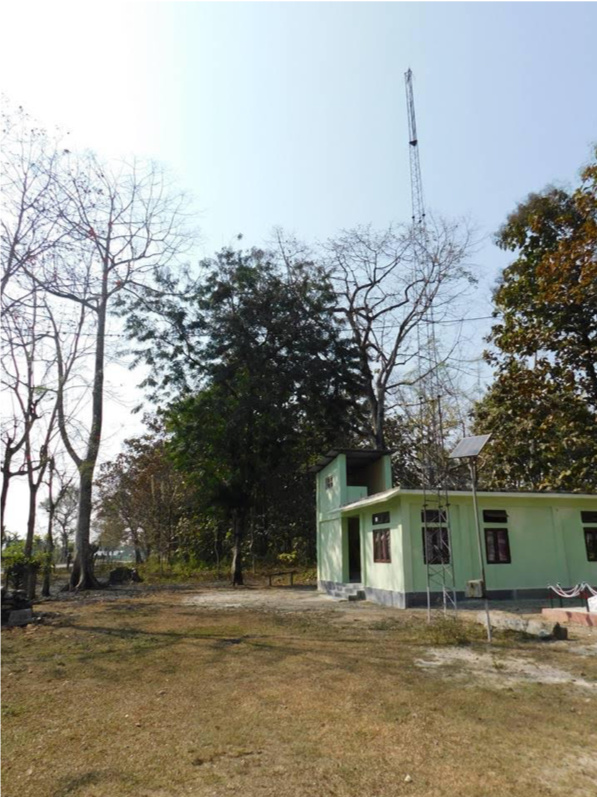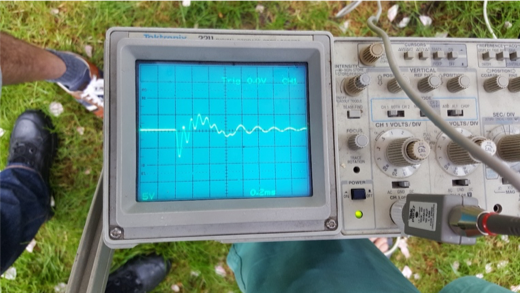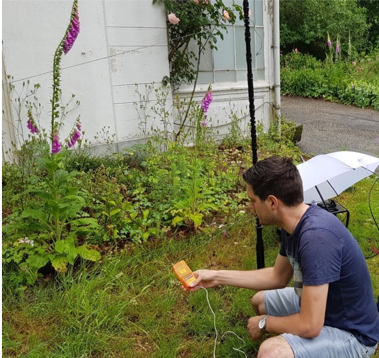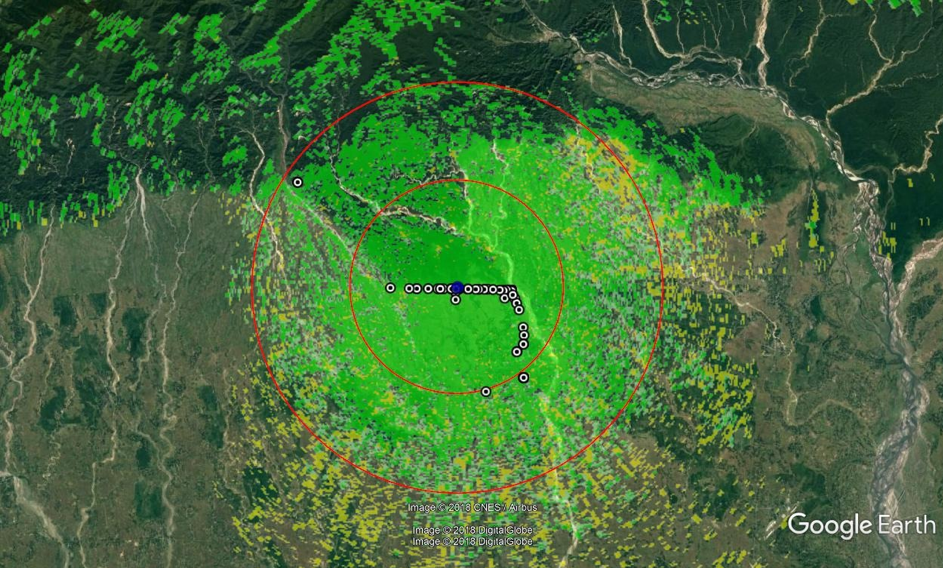A quick recap of our mission
Our project in partnership with WWF and WILDLABS aims to provide a low maintenance, low-cost monitoring system for the electric fences that aim to reduce human-wildlife conflicts with especially elephants. At our project site in the Sonitpur District, India our plan was to set up the required infrastructure, including the installation of LoRaWAN™ gateway along the fenced borders of the district. This network gives us also the ability to add several other sensors such as GPS tracking devices and Arribada’s thermopile infrared sensors (the other winners of the HWC Tech Challenge).
One of the first milestones was to establish a stable network. Once we had that up and running, we were able to deploy our fence monitoring systems.

Figure 1: Gateway setup at the highest point in the area
So how do they work? A fence sensor measures the power leaks in the electric fence and notifies us when the first line of protection is interrupted, in other words when an elephant breaks through the fence. Once an elephant goes over a fence-line, there’s a serious risk that it will move through farmland, potentially damaging crops and infrastructure. Elephants can be injured or killed in retaliation, or can kill or injure civilians. Human-wildlife conflicts lead to hundreds of deaths each year, showing the importance of a reliable solution. Another use case for having these kinds of sensors is that the measurements also give you an indication of a malfunctioning fence. In this situation, the sensor would be able to give a warning when a solar-battery in the field is drained.
While the fence sensors collect the data, it becomes just as important to translate this raw data into useful information for rangers or other security personnel. This translation happens in our self-built Smart Parks application. It’s a user-friendly web application that shows all the sensor data in a clear and accessible way. Once activated this increase of situational awareness can be used to monitor the fence and ranger team can receive a signal immediately once something is trying to breach the fence. The application also allows external data to be integrated, for example, the Arribada’s elephant thermal camera data.
Besides the application in the control room, we also want to warn people once an elephant or another animal has breached the fence. That’s why we installed an alarm system. As soon as the sensors detect a power failure or when an elephant gets close to a populated area the alarm activates a buzzer flashlight to warn the villagers. The test setup of the alarm has been working since our first arrival in India and shows to be ready for further integration. We would still like to add other features to the alarm as well, such as an SMS and email-messaging service. This could then be used when a thermopile infrared sensor for example gets triggered.
Deployment and sensor testing
After our first deployment, we left the site in India with five active High Voltage probes and an Alarm unit. The first probes we installed in the Assam region consumed a high amount of energy, so we needed to replace them after a couple of months. Due to the different stages of development, these prototypes also didn’t have the Bluetooth interface activated to upgrade the firmware if needed. Nevertheless, we were hopeful that these first probes would give use stable measurements of the voltage, but in reality, it turned out it wasn’t the case.

Figure 2: Receiving incorrect voltages
What happened was that depending on the position of the sensor on the fence line the reported voltages were incorrect. For example, the probe that was placed directly at the first energizer close to camp showed significant deviations. To validate the test results, we compared the voltage indicator on the energizer and an official field tester.
To give us some insight on the quality of the fence line, the probes were programmed to count the high voltage pulses. Our probes reported too many pulses in relation to the expected one pulse per second interval. With this information, we knew we had to create our own high voltage fence test system to create better sensor configuration.

Figure 3: The fence setup in the Netherlands
Back in the Netherlands, we created a fence network to see whether the electric fence itself needed a different setup or whether the probes needed an improved configuration. The latter proved to be the case. In layman’s terms: we had to change the trigger moment on which our sensor would capture the high voltage pulse. As shown on Figure 4 belopw, there’s a moment where high pulse rises and a moment where it falls. Our prototypes were programmed to measure on the rise, but the energy flow is not a steady current, it’s a capricious line meaning that what appears to be a rising pulse sometimes isn’t. Once we changed the configuration to the falling time, we received a lot more reliable and constant measurements.

Figure 4: The rise and fall time of the current
During the development of our improved sensors it became apparent that it is difficult to create a general sensor to monitor an electric fence. As every energizer and every current flow are different it is important that we develop a sensor that is suitable for every individual deployment without having to configure it on site.
We took these new parameters into account and started a new design for our sensor in the Netherlands. This phase is now completed and created an improved High Voltage Fence Sensor that is now ready for its implementation in India.

Figure 5: Our probe on the design table
Network testing
With a LoRaWAN™ gateway up and running in the field, WWF India got curious about potential other applications that fall under our Smart Parks solution. A range test was one of their first requests to see whether the use of GPS-trackers for animals, rangers and vehicles is feasible as well. To achieve this, we sent our latest GPS-sensor (Figure 6) for testing to the team on the ground.

Figure 6: GPS vehicle tracker in India
Immediately the range showed the enormous potential of the LoRaWAN network technology. We got a 15-kilometer range (Figure 7), but unfortunately not in all cases. The density of the coverage interfered with the signals' reach (Figure 8). However, this was one of the expectations we had when we installed the gateway at the radio tower at the ranger’s site. The surrounding trees block the signal because the top of the tower doesn’t reach above the surrounding canopy. Moreover, as usual with radio frequency; you have to get some sort of line of sight. So, the solution is simple, either build a higher tower or cut the trees. Needless to say, it's clear what we environmentalists prefer.

Figure 7: The green shows the coverage of the network

Figure 8: The green dots are the GPS tracker
The Application
Since the sensors in the field reported a substantial amount of data, we started to add a new functionality to the Smart Parks web application to handle and display the data. In the end, the way the data is presented is vital in the decision-making process to prevent any human wildlife conflict.
The screenshot show in Figure 9 gives you an idea of how the rangers can see whether a fence line or an individual fence section is adequately powered. Combined with other information a ranger can immediately take action if necessary.

Figure 9: Screenshot of our application
Next steps
Our immediate next step is to deploy five improved fence-sensors (Figure 10) at our test-site in Assam, so we continue the project in the field with WWF India.

Figure 10: The new sensor
As soon as the sensors are reposting the right values, we can continue with the rest of the use-case, which is the logic of triggering alarms and notifications for the villages and rangers. But we’ll also continue to provide the support needed to implement other sensors and getting the most out of a Smart Parks network.


Add the first post in this thread.